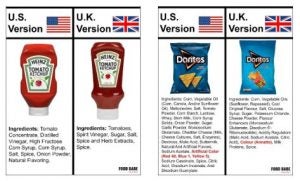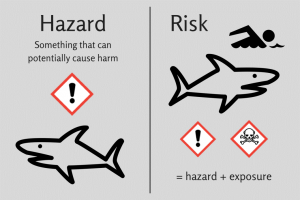I’m sure you’re all aware by now that nothing Food Babe writes about is evidence-based. However, many people have sent me these Food Babe-derived graphics that have been circulating recently and are being shared by some other accounts with large followings. So, I’d like to address whether there is any validity to them.
Here are a couple of the graphics:

She goes on to claim that these companies sell “safer, better products overseas while making inferior versions to sell to Americans.” The basic premise is that she asserts that the UK versions of these products are safer and healthier since they have fewer ingredients listed and don’t contain ingredients that may be banned in some countries or require warning labels.
So, let’s take a look at the Heinz ketchup first. She claims that:
Heinz ketchup is GMO-free in the U.K., but full of GMOs and High Fructose Corn Syrup in the U.S., along with lab-produced “natural flavoring” that helps create an addiction to their product.
First, the length of the ingredient declaration tells you nothing about the safety or healthfulness of a product. Even 100 percent natural fruits, such as the banana, are made up entirely of many different chemical compounds. Second, GMOs are just as safe and at least as nutritious as their non-GMO counterparts. That’s an international scientific consensus. Not to mention the fact that the “GMO” ingredients in this ketchup are refined corn syrups, so they don’t even contain genetic material, and therefore, are not “full of GMOs,” which is a pretty meaningless phrase to begin with. Lastly, the UK and the U.S. have different labeling regulations, so the “natural flavoring” in the U.S. version could be the same as the “spice and herb extracts” listed on the UK version.
Even if they are different chemical compounds, “natural flavoring” doesn’t mean that it’s somehow less safe than “spice and herb extracts,” and there’s certainly no evidence to show that these flavors make the product addictive. I don’t think ketchup addiction is a real issue. These two products are essentially the same. Basically, they are both tomato, vinegar, sugar, salt, and spices. She also mentions the fact that the U.S. version contains high fructose corn syrup (HFCS), while the UK version uses sugar. She takes every opportunity she can to fearmonger over HFCS, but the evidence shows that HFCS is no worse for you than sugar. They have almost the exact same sugar profile. HFCS is most commonly available as 42 percent fructose (HFCS-42) and 55 percent fructose (HFCS-55). Despite the name “high-fructose,” HFCS actually has approximately the same amount of fructose and glucose as sucrose or honey. HFCS is only “high” in fructose compared to the corn syrup from which it’s derived. This study, this study, and this study comparing intake of sucrose, HFCS, and other similar sweeteners such as honey have found they exert similar metabolic effects, and that HFCS does not uniquely contribute to weight gain. So, the evidence does not support Food Babe’s misinformed opinion that the UK ketchup is safer or more nutritious than the U.S. version.
Now, let’s take a look at the Doritos graphics. Food Babe says, and I quote:
American Doritos are covered in artificial dyes made from petroleum (Red #40, Blue #1, and Yellow #5). In the U.K., these dyes require a warning label that says “May Have an Adverse Effect on Activity and Attention in Children.”
First, it’s important to note that the U.S. takes a risk-based approach when it comes to the approval food ingredients, while Europe takes a hazard-based approach. Whether an ingredient is banned in a country tells you nothing about its safety. The decision to ban an ingredient is not always an evidence-based one. It can be politically motivated or based off of consumer fears perpetuated by people such as Food Babe.
A hazard is an agent that has the potential to cause harm, while risk measures the likelihood of harm from a hazard. Risk = Hazard + Exposure. Hazard identification is the first step of risk assessment, but is not in and of itself a risk assessment. Under a hazard based scenario, costs and benefits are often not considered. Products are regularly banned or heavily restricted if they are deemed to pose theoretical hazards, only to be replaced by less effective products, which, and often because of political reasons, remain available for use even though their toxicity profile is far more problematic.
Europe’s hazard-based approach, which is the application of what is known as the “precautionary principle,” is a problematic tool for policy. Given that every substance is potentially carcinogenic, if exposure levels are not taken into account, everything conceivably could be regulated off the market. One of Food Babe’s famous sayings is that Americans are the “lab rats,” since our policies are not based on the precautionary principle, but this couldn’t be further from the truth. Food and color additives are more strictly studied, regulated, and monitored than at any other time in history. Food additives have to pass extensive safety testing before being approved for food use. Once an additive is approved, the FDA issues regulations that may include the types of foods in which it can be used, the maximum amounts and how it should be identified on food labels.

OK, so back to the Doritos example, where she specifically calls out the artificial colors and claims they are less safe than the annatto used in the UK version. This is another false assumption on Food Babe’s part. Naturally derived colors and flavors are not necessarily safer than their synthetic counterparts. In many cases they are less researched, have greater potential to cause an allergic reaction, and obtaining them may cause more damage to the environment. I have written about food additives previously. There are nine certified color additives approved for use in the U.S., for example, FD&C Yellow No. 6. Colors that are exempt from certification include pigments derived from natural sources such as vegetables, minerals, or animals. These colors may add unintended flavors to foods, are typically more expensive, and are less pure and less stable than their artificial counterparts. Examples include: annatto extract, beta-carotene, and dehydrated beets. Certified colors have undergone extensive testing and have been found to be safe in the amount present in food. Exempt colors have not been tested as thoroughly as certified colors, but still must comply with regulatory requirements.
So, what about that warning label that’s required in Europe for artificial colors? Well, it turns out that it’s based off of one study that was conducted in 2007 in which 137 3-year-old children and 130 8-/9- year old children were given three different types of beverages to drink. Then their behavior was evaluated by teachers and parents. One of the drink mixtures contained four different artificial food colorings as well as the preservative sodium benzoate. The second drink mixture also included four different artificial food colorings (two of them were the same as the ones in the first drink mixture) as well as the preservative sodium benzoate. The third drink mixture was a placebo and contained no additives. Wow, that’s a lot of variables. The researchers found that hyperactive behavior by the 8- and 9-year-olds increased with both the mixtures containing artificial coloring additives. The hyperactive behavior of 3-year-olds increased with the first beverage but not necessarily with the second. Remember, these were simply observations by teachers and parents based on drinks with many different variables. Really nothing definitive can be concluded from it.
This more recent meta-analysis shows that the data is inconclusive and concluded that, “A restriction diet benefits some children with ADHD. Effects of food colors were notable but susceptible to publication bias or were derived from small, nongeneralizable samples. Renewed investigation of diet and ADHD is warranted.” Yet despite this more recent meta-analysis and the fact that links between color additives and ADHD have been inconclusive, inconsistent, and difficult to interpret due to inadequacies in study design, this warning is still required in Europe. However, despite much less research on natural colors, they don’t require any warning. This is the precautionary principle in action.
It becomes clear from these two examples that varying labeling regulations as well as hazard- vs. risk-based approaches can explain the differences between products and the way they are labeled in different countries. Availability and cost of ingredients and consumer preferences can play a role in the differing formulations as well. Just because the same product may have a slightly different formulation from country to country (which is quite common) or a longer ingredient list doesn’t mean that something sinister is going on or that one is safer or inferior to the other. We have the safest, most abundant food supply in history, but that doesn’t stop people such as Food Babe from demonizing what she so clearly doesn’t understand. Perhaps we should take a risk-based approach to her misinformation, which surely is hazardous, by reducing our exposure to zero.
Food Science Babe is the pseudonym of an agvocate and writer who focuses specifically on the science behind our food. She has a degree in chemical engineering and has worked in the food industry for more than decade, both in the conventional and in the natural/organic sectors.



